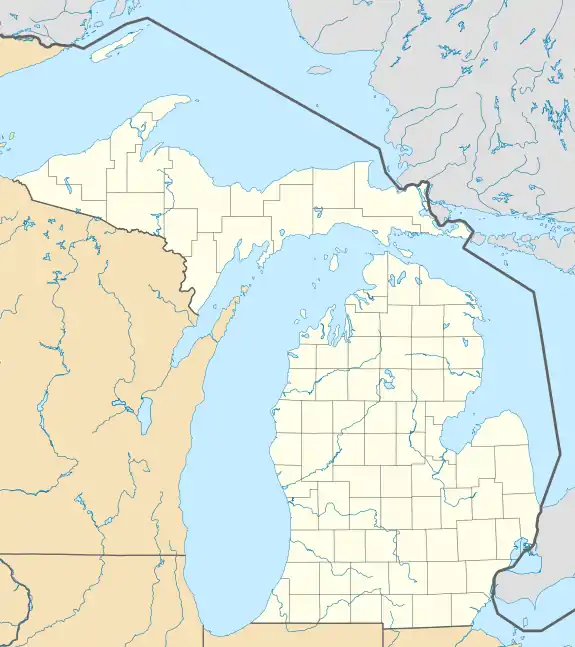Williamsburg, Michigan | |
|---|---|
| Coordinates: 44°46′25″N 85°24′14″W / 44.77361°N 85.40389°W | |
| Country | |
| State | |
| County | |
| Township | Whitewater |
| Established | 1856 |
| Elevation | 735 ft (224 m) |
| Time zone | UTC-5 (Eastern (EST)) |
| • Summer (DST) | UTC-4 (EDT) |
| ZIP code(s) | 49690 |
| Area code | 231 |
| GNIS feature ID | 1616512[1] |
Williamsburg is an unincorporated community in the U.S. state of Michigan. The community is located within Whitewater Township, Grand Traverse County, and is part of the Northern Lower Peninsula.[2] A post office operates in Williamsburg with the ZIP code 49690. Williamsburg is home to Turtle Creek Casino and Hotel.
History
There is evidence that three different cultures of people have lived in this area since 10,500 BC, especially on Skegemog Point in Lake Skegemog and Elk Lake. Records show that a branch of the Algonquin people, known as the Mascoutin, lived in the area until around 1630s. The Ottawa and Chippewa peoples came in after this, until the early 1800s.[3]
In 1856, three families from Monroe County, New York, settled the area, and called it Mill Creek. In 1867, the community was given a post office, named Dunbar, after its first postmaster. The post office was renamed to Williamsburgh in 1869, and the "h" was later dropped in 1894.[4]
In 1892, an extension of the Chicago and West Michigan Railroad opened through Williamsburg.[5] In 1982, the rail line, which had previously extended to Charlevoix and Petoskey, was terminated at Williamsburg.[6]
In 1973, 100 to 150 sinkholes opened up around the town caused by natural gas leaks.[7] The sinkholes were caused by increased oil and natural gas drilling operations caused by the 1973 oil crisis. The leaks started when Amoco well E1-22 struck a pocket of natural gas under the village. The gas was then over pressurized, and tore open holes in the surface soil. Residents were evacuated and an exclusion zone was established. Few pictures of the event remain, as fears that the spark of a camera could light the gas in the air, causing the whole town to spontaneously combust. The newly constructed thoroughfare into Traverse City, M-72, was rendered completely unusable after the event. A class action lawsuit was filed by residents that had been displaced for several months during the event. Silt that had become disturbed along creeks and streams in the area had poured in to the Grand Traverse Bay and raised environmental concerns and concerns over the safety of the usually clear water.[8]
Transportation
Major highway
 M-72 runs east–west directly through the town, providing access to Traverse City and Kalkaska.
M-72 runs east–west directly through the town, providing access to Traverse City and Kalkaska.
Notable resident
- Adam Trautman, National Football League (NFL) tight end, grew up in Williamsburg.[9]
References
- 1 2 "Williamsburg". Geographic Names Information System. United States Geological Survey, United States Department of the Interior.
- ↑ "Geographic Names Information System". edits.nationalmap.gov. Retrieved June 4, 2023.
- ↑ "History: Whitewater Township". Whitewater Township Historical Society. Retrieved November 19, 2017.
- ↑ Romig, Walter (1986). Michigan Place Names: The History of the Founding and the Naming of More Than Five Thousand Past and Present Michigan Communities. Detroit: Wayne State University Press. p. 604. ISBN 0-8143-1838-X.
- ↑ "michiganrailroads.com - Evolution Map - Lower - 1892". www.michiganrailroads.com. Retrieved March 18, 2023.
- ↑ "michiganrailroads.com - Evolution Map - Lower - 1982". www.michiganrailroads.com. Retrieved March 18, 2023.
- ↑ "Natural gas leak nearly destroyed Michigan village this week in 1973". MLive. Booth Newspapers. Retrieved March 19, 2018.
- ↑ "When Williamsburg Erupted". Interlochen Public Radio. N/A. Retrieved January 30, 2021.
- ↑ Brugler, Dane. "Meet the Prospect: Dayton's Adam Trautman transitions from small-town QB to NFL TE prospect". The Athletic. Retrieved February 24, 2022.

